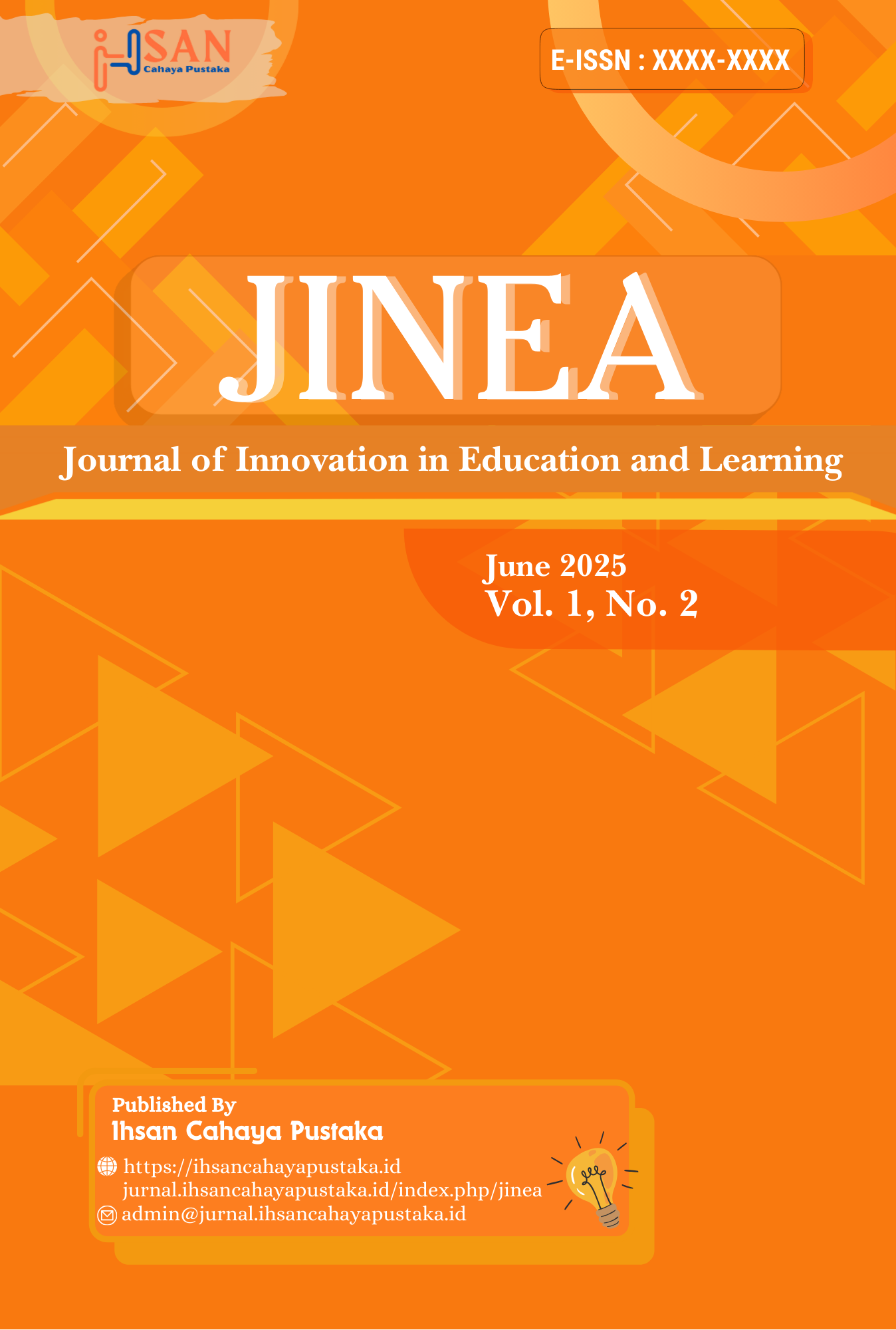Digital Learning 5.0: Leveraging Adaptive, Immersive, and Inclusive Technologies to Overcome Educational Inequity
Keywords:
Digital Learning 5.0, Adaptive Learning, Immersive Technology, Inclusive Education, Educational EquityAbstract
Digital Learning 5.0, emphasizing adaptability, immersion, and inclusivity, offers a promising approach to reducing educational inequities. This study aims to examine how these technologies are conceptualized and implemented to enhance equitable learning opportunities. A qualitative case study was conducted through an integrative literature review, analyzing peer-reviewed articles, conference proceedings, and authoritative reports from major databases. Data were synthesized to identify key strategies, frameworks, and outcomes of Digital Learning 5.0 across diverse educational contexts. Findings reveal that combining adaptive learning platforms with immersive and inclusive features creates an engaging, personalized, and accessible learning ecosystem. This approach improves learner motivation, knowledge retention, academic performance, and equitable access for students, including those with disabilities and from underrepresented backgrounds. The study underscores the importance of strategic investment, professional development, and inclusive design in education, providing practical and policy implications for implementing Digital Learning 5.0 to achieve high-quality and equitable learning outcomes.
Downloads
References
Afrita, J. (2023). Peran Artificial Intelligence dalam Meningkatkan Efisiensi dan Efektifitas Sistem Pendidikan. COMSERVA: Jurnal Penelitian Dan Pengabdian Masyarakat, 2(12). https://doi.org/10.59141/comserva.v2i12.731
Aggarwal, D. (2023). Exploring the Scope of Artificial Intelligence (AI) for Lifelong Education through Personalised & Adaptive Learning. Journal of Artificial Intelligence, Machine Learning and Neural Network, 41. https://doi.org/10.55529/jaimlnn.41.21.26
Ahmad, S. T., Watrianthos, R., Samala, A. D., Muskhir, M., & Dogara, G. (2023). Project-based Learning in Vocational Education: A Bibliometric Approach. International Journal of Modern Education and Computer Science, 15(4). https://doi.org/10.5815/ijmecs.2023.04.04
Akinwalere, S. N., & Ivanov, V. (2022). Artificial Intelligence in Higher Education: Challenges and Opportunities. Border Crossing, 12(1). https://doi.org/10.33182/bc.v12i1.2015
Alainati, S., Al-Hunaiyyan, A., & Alkhatib, H. (2023). Instructors’ Digital Competencies for Innovative Learning: Human Resource Management Perspectives. International Journal of Professional Business Review, 8(10). https://doi.org/10.26668/businessreview/2023.v8i10.3750
Alamsyah, Burhamzah, M., Fatimah, S., & Asri, W. K. (2022). Peran guru dalam menghadapi era society 5.0: Apakah sebatas tantangan atau perubahan? Maruki: Jurnal Ilmu Pendidikan Islam, 1(1).
Alzain, A. M., Clark, S., Jwaid, A., & Ireson, G. (2018). Adaptive education based on learning styles: Are learning style instruments precise enough? International Journal of Emerging Technologies in Learning, 13(9). https://doi.org/10.3991/ijet.v13i09.8554
Asenova, M., Del Zozzo, A., & Santi, G. (2023). Unfolding Teachers’ Interpretative Knowledge into Semiotic Interpretative Knowledge to Understand and Improve Mathematical Learning in an Inclusive Perspective. Education Sciences, 13(1). https://doi.org/10.3390/educsci13010065
Basantia, T. K., & Kumar, V. (2022). Massive open online courses as alternatives to conventional education and existing distance education. International Journal of Virtual and Personal Learning Environments, 12(1). https://doi.org/10.4018/IJVPLE.306233
Bervell, B., & Arkorful, V. (2020). LMS-enabled blended learning utilization in distance tertiary education: establishing the relationships among facilitating conditions, voluntariness of use and use behaviour. International Journal of Educational Technology in Higher Education, 17(1). https://doi.org/10.1186/s41239-020-0183-9
Cervera, M. G., & Caena, F. (2022). Teachers’ digital competence for global teacher education. European Journal of Teacher Education, 45(4), 451–455. https://doi.org/10.1080/02619768.2022.2135855
Chandler, T., Richards, A. E., Jenny, B., Dickson, F., Huang, J., Klippel, A., Neylan, M., Wang, F., & Prober, S. M. (2022). Immersive landscapes: modelling ecosystem reference conditions in virtual reality. Landscape Ecology, 37(5). https://doi.org/10.1007/s10980-021-01313-8
Cho, Y., & Park, K. S. (2023). Designing Immersive Virtual Reality Simulation for Environmental Science Education. Electronics (Switzerland), 12(2). https://doi.org/10.3390/electronics12020315
Christodoulou, A., & Angeli, C. (2022). Adaptive Learning Techniques for a Personalized Educational Software in Developing Teachers’ Technological Pedagogical Content Knowledge. Frontiers in Education, 7. https://doi.org/10.3389/feduc.2022.789397
De Vega, N., & Rahayu. (2023). Enhancing English Learning: Self-Determination in Indonesia Digital Classrooms. Inspiring: English Education Journal, 6(2). https://doi.org/10.35905/inspiring.v6i2.6611
Dickinson, K. J., & Gronseth, S. L. (2020). Application of Universal Design for Learning (UDL) Principles to Surgical Education During the COVID-19 Pandemic. Journal of Surgical Education, 77(5). https://doi.org/10.1016/j.jsurg.2020.06.005
Doroudi, S. (2023). The Intertwined Histories of Artificial Intelligence and Education. International Journal of Artificial Intelligence in Education, 33(4). https://doi.org/10.1007/s40593-022-00313-2
Edyburn, D. L. (2021). Universal Usability and Universal Design for Learning. Intervention in School and Clinic, 56(5). https://doi.org/10.1177/1053451220963082
Espada-Chavarria, R., González-Montesino, R. H., López-Bastías, J. L., & Díaz-Vega, M. (2023). Universal Design for Learning and Instruction: Effective Strategies for Inclusive Higher Education. Education Sciences, 13(6). https://doi.org/10.3390/educsci13060620
Evers, S., Dane, G. Z., van den Berg, P. E. W., Klippel, A. K. A. J., Verduijn, T., & Arentze, T. A. (2023). Designing healthy public spaces: A participatory approach through immersive virtual reality. AGILE: GIScience Series, 4. https://doi.org/10.5194/agile-giss-4-24-2023
García-Martínez, J. A., Rosa-Napal, F. C., Romero-Tabeayo, I., López-Calvo, S., & Fuentes-Abeledo, E. J. (2020). Digital tools and personal learning environments: An analysis in higher education. Sustainability (Switzerland), 12(19). https://doi.org/10.3390/su12198180
Gobinath, T. (2024). Society 5.0 The Next Revolution in Human Progress. Shanlax International Journal of Arts, Science and Humanities, 11(3). https://doi.org/10.34293/sijash.v11i3.6898
Gong, Y. (2021). Application of virtual reality teaching method and artificial intelligence technology in digital media art creation. Ecological Informatics, 63. https://doi.org/10.1016/j.ecoinf.2021.101304
Hanisch, S., & Eirdosh, D. (2023). Behavioral Science and Education for Sustainable Development: Towards Metacognitive Competency. Sustainability (Switzerland), 15(9). https://doi.org/10.3390/su15097413
Harahap, N. J., Limbong, C. H., & Sinaga Simanjorang, E. F. (2023). The Education in Era Society 5.0. Jurnal Eduscience, 10(1). https://doi.org/10.36987/jes.v10i1.3959
Hargitai, D. M., & Bencsik, A. (2023). The Role of Leadership in Digital Learning Organizations. Emerging Science Journal, 7(Special issue 2). https://doi.org/10.28991/ESJ-2023-SIED2-09
Hashim, N. C., Majid, N. A. A., Arshad, H., Hashim, H., & Abdi Alkareem Alyasseri, Z. (2022). Mobile Augmented Reality Based on Multimodal Inputs for Experiential Learning. IEEE Access, 10. https://doi.org/10.1109/ACCESS.2022.3193498
Hizam-Hanafiah, M., & Soomro, M. A. (2021). The situation of technology companies in industry 4.0 and the open innovation. Journal of Open Innovation: Technology, Market, and Complexity, 7(1). https://doi.org/10.3390/joitmc7010034
Huang, J., Saleh, S., & Liu, Y. (2021). A review on artificial intelligence in education. Academic Journal of Interdisciplinary Studies, 10(3). https://doi.org/10.36941/AJIS-2021-0077
Huang, Z., Fey, M., Liu, C., Beysel, E., Xu, X., & Brecher, C. (2023). Hybrid learning-based digital twin for manufacturing process: Modeling framework and implementation. Robotics and Computer-Integrated Manufacturing, 82. https://doi.org/10.1016/j.rcim.2023.102545
Indah, R. N., Toyyibah, Budhiningrum, A. S., & Afifi, N. (2022). The research competence, critical thinking skills and digital literacy of indonesian efl students. Journal of Language Teaching and Research, 13(2). https://doi.org/10.17507/jltr.1302.11
Jamiludin, J., & Darnawati, D. (2022). E-learning on History learning: Aspect of material, teacher, learning environment, and student. International Journal of Evaluation and Research in Education, 11(2). https://doi.org/10.11591/ijere.v11i2.22471
Joshi, M. (2023). Adaptive Learning through Artificial Intelligence. SSRN Electronic Journal. https://doi.org/10.2139/ssrn.4514887
Kaliraj, P., Singaravelu, G., & Devi, T. (2024). Transformative Digital Technology for Disruptive Teaching and Learning. In Transformative Digital Technology for Disruptive Teaching and Learning. https://doi.org/10.1201/9781032675176
Kelly, O., Buckley, K., Lieberman, L. J., & Arndt, K. (2022). Universal Design for Learning - A framework for inclusion in Outdoor Learning. Journal of Outdoor and Environmental Education, 25(1). https://doi.org/10.1007/s42322-022-00096-z
Kim, D., & Ryoo, D. (2023). Learning Techniques Using Study With Me: Focus on Motivational Orientations, Learning Competency, and Digital Literacy. IEEE Access, 11. https://doi.org/10.1109/ACCESS.2023.3312555
Kim, K. G., Oertel, C., Dobricki, M., Olsen, J. K., Coppi, A. E., Cattaneo, A., & Dillenbourg, P. (2020). Using immersive virtual reality to support designing skills in vocational education. British Journal of Educational Technology, 51(6). https://doi.org/10.1111/bjet.13026
Kugler, E., & Kárpáti, A. (2023). Teaching Mathematics through art: Developing spatial skills and digital literacy of children with learning challenges through visual arts education. In Arts-Based Interventions and Social Change in Europe. https://doi.org/10.4324/9781003376927-6
Lau, K. W. (2023). Learning game innovations in immersive game environments: a factor analytic study of students’ learning inventory in virtual reality. Virtual Reality, 27(3). https://doi.org/10.1007/s10055-023-00811-1
Liaw, S. Y., Choo, T., Wu, L. T., Lim, W. S., Choo, H., Lim, S. M., Ringsted, C., Wong, L. F., Ooi, S. L. W., Lau, T. C., Lee, U., Choi, H., Jeon, Y., Sweigart, L. I., Umoren, R. A., Scott, P. J., Carlton, K. H., Jones, J. A., Truman, B., … Fetters, M. D. (2021). Creating contextual learning experiences via virtual simulation. Clinical Simulation in Nursing, 21(3).
Liu, H. L., Wang, T. H., Lin, H. C. K., Lai, C. F., & Huang, Y. M. (2022). The Influence of Affective Feedback Adaptive Learning System on Learning Engagement and Self-Directed Learning. Frontiers in Psychology, 13. https://doi.org/10.3389/fpsyg.2022.858411
Lowell, V. L., & Yan, W. (2024). Applying Systems Thinking for Designing Immersive Virtual Reality Learning Experiences in Education. TechTrends, 68(1). https://doi.org/10.1007/s11528-023-00922-1
Mansur, H., Utama, A. H., Mohd Yasin, M. H., Sari, N. P., Jamaludin, K. A., & Pinandhita, F. (2023). Development of Inclusive Education Learning Design in the Era of Society 5.0. Social Sciences, 12(1). https://doi.org/10.3390/socsci12010035
Mathur, J., Miller, S. R., Simpson, T. W., & Meisel, N. A. (2023). Designing immersive experiences in virtual reality for design for additive manufacturing training. Additive Manufacturing, 78. https://doi.org/10.1016/j.addma.2023.103875
Mavlutova, I., Lesinskis, K., Liogys, M., & Hermanis, J. (2020). Innovative teaching techniques for entrepreneurship education in the era of digitalisation. WSEAS Transactions on Environment and Development, 16. https://doi.org/10.37394/232015.2020.16.75
Mirata, V., & Bergamin, P. (2023). Role of organisational readiness and stakeholder acceptance: an implementation framework of adaptive learning for higher education. Educational Technology Research and Development, 71(4). https://doi.org/10.1007/s11423-023-10248-7
Monreal, J., & Panoy, J. F. (2023). Development and Evaluation of Design Thinking-based Learning Packets for Enhancing Innovation Skills. International Journal of Science, Technology, Engineering and Mathematics, 3(3). https://doi.org/10.53378/353005
Montero Guerra, J. M., Danvila-del-Valle, I., & Méndez Suárez, M. (2023). The impact of digital transformation on talent management. Technological Forecasting and Social Change, 188. https://doi.org/10.1016/j.techfore.2022.122291
Muñoz-Arteaga, J., López-Torres, G. C., & Muñoz-Zavala, Á. E. (2023). An Agile Learning Methodology to Support Inclusive Education. Edutec, 86. https://doi.org/10.21556/edutec.2023.86.3013
Murtiyasa, B., Jannah, I. M., & Rejeki, S. (2020). Designing mathematics learning media based on mobile learning for ten graders of vocational high school. Universal Journal of Educational Research, 8(11). https://doi.org/10.13189/ujer.2020.081168
Muxtorjonovna, A. M. (2020). Significance Of Blended Learning In Education System. The American Journal of Social Science and Education Innovations, 02(08). https://doi.org/10.37547/tajssei/volume02issue08-82
Park, H., Cooper, G., & Thong, L. P. (2022). Designing an Immersive Virtual Reality Classroom Exploring Behaviour Support Strategies. Video Journal of Education and Pedagogy, 35(11). https://doi.org/10.1163/23644583-bja10030
Paulsen, L., Dau, S., & Davidsen, J. (2024). Designing for collaborative learning in immersive virtual reality: a systematic literature review. Virtual Reality, 28(1). https://doi.org/10.1007/s10055-024-00975-4
Pellas, N., Dengel, A., & Christopoulos, A. (2020). A Scoping Review of Immersive Virtual Reality in STEM Education. In IEEE Transactions on Learning Technologies (Vol. 13, Issue 4). https://doi.org/10.1109/TLT.2020.3019405
Pozo, J. I., Pérez Echeverría, M. P., Cabellos, B., & Sánchez, D. L. (2021). Teaching and Learning in Times of COVID-19: Uses of Digital Technologies During School Lockdowns. Frontiers in Psychology, 12. https://doi.org/10.3389/fpsyg.2021.656776
Safira, I., Wahid, A., Rahmadhanningsih, S., Suryadi, A., & Swandi, A. (2021). The Relationship between Students’ Learning Motivation and Learning Outcomes through Guided Discovery Model Assisted Video and Interactive Simulation. Jurnal Pendidikan Fisika, 9(2).
Salikhova, N. R., Lynch, M. F., & Salikhova, A. B. (2020). Psychological aspects of digital learning: A self-determination theory perspective. Contemporary Educational Technology, 12(2). https://doi.org/10.30935/cedtech/8584
Sanusi, I. T., Olaleye, S. A., Agbo, F. J., & Chiu, T. K. F. (2022). The role of learners’ competencies in artificial intelligence education. Computers and Education: Artificial Intelligence, 3. https://doi.org/10.1016/j.caeai.2022.100098
Savelyeva, T., & Park, J. (2022). Blockchain technology for sustainable education. British Journal of Educational Technology, 53(6). https://doi.org/10.1111/bjet.13273
Sharma, H. L., & Priyamvada. (2022). Innovative Teaching Strategies To Foster Critical Thinking: a Review. International Journal of Creative Research Thoughts, 10(5).
Sihabudin. (2021). Blended Learning Strategi Pembelajaran di Era Digital. In Nucl. Phys.
Subandowo, M. (2022). Teknologi Pendidikan di Era Society 5.0. Sagacious: Jurnal Ilmiah Pendidikan Dan Sosial, 9(1).
Subramanian, N. (2022). Tone of Cognition and Metacognition in Digital Learning Environments. In Industry 4.0 Technologies for Education. https://doi.org/10.1201/9781003318378-29
Supa’at, S., & Ihsan, I. (2023). The Challenges of Elementary Education in Society 5.0 Era. International Journal of Social Learning (IJSL), 3(3). https://doi.org/10.47134/ijsl.v3i3.214
Supriyadi, S. (2022). Hybrid Learning on Digital Literacy in The Implementation of Curriculum Merdeka. Jurnal Inovasi Pendidikan MH Thamrin, 6(2). https://doi.org/10.37012/jipmht.v6i2.771
Tajudeen, F. P., Nadarajah, D., Jaafar, N. I., & Sulaiman, A. (2022). The impact of digitalisation vision and information technology on organisations’ innovation. European Journal of Innovation Management, 25(2). https://doi.org/10.1108/EJIM-10-2020-0423
Timotheou, S., Miliou, O., Dimitriadis, Y., Sobrino, S. V., Giannoutsou, N., Cachia, R., Monés, A. M., & Ioannou, A. (2023). Impacts of digital technologies on education and factors influencing schools’ digital capacity and transformation: A literature review. Education and Information Technologies, 28(6). https://doi.org/10.1007/s10639-022-11431-8
Toader, T., Safta, M., Titirișcă, C., & Firtescu, B. (2021). Effects of digitalisation on higher education in a sustainable development framework—online learning challenges during the covid-19 pandemic. Sustainability (Switzerland), 13(11). https://doi.org/10.3390/su13116444
Upadhayaya, P. R. (2023). Information Communication Technology in Education: Bringing Innovation in Classroom. Ganeshman Darpan, 8(1). https://doi.org/10.3126/gd.v8i1.57335
Wahyu Pratama Putra, Munawir Yusuf, & Agus Effendi. (2023). Innovation of Digital-Based Instructional Design and Virtual Reality on Geography Subject for 10th Grade High School. Journal of Education Technology, 7(1). https://doi.org/10.23887/jet.v7i1.51702
Wartiningsih, & Surjono, H. D. (2020). Adaptive E-Learning Model in Learning Personality Characters. https://doi.org/10.2991/assehr.k.200521.004
Windram, J. D., Neal, A., & McMahon, C. J. (2023). Evolution in Congenital Cardiology Education: The Rise of Digital-Learning Tools. CJC Pediatric and Congenital Heart Disease, 2(2). https://doi.org/10.1016/j.cjcpc.2022.12.005
Yang, P., & Liu, Z. (2022). The Influence of Immersive Virtual Reality (IVR) on Skill Transfer of Learners: The Moderating Effects of Learning Engagement. International Journal of Emerging Technologies in Learning, 17(10). https://doi.org/10.3991/ijet.v17i10.30923
Ylipulli, J., Pouke, M., Ehrenberg, N., & Keinonen, T. (2023). Public libraries as a partner in digital innovation project: Designing a virtual reality experience to support digital literacy. Future Generation Computer Systems, 149. https://doi.org/10.1016/j.future.2023.08.001
Zhang, R., & Zhao, X. (2020). The application of folk art with virtual reality technology in visual communication. Intelligent Automation and Soft Computing, 26(4). https://doi.org/10.32604/iasc.2020.010113
Downloads
Published
Data Availability Statement
All data generated or analyzed during this study are included in this published article. Additional datasets are available from the corresponding author upon reasonable request.
Issue
Section
License
Copyright (c) 2025 Duwi Purnama Sidik S. Kom., Fitri Irawijayanti, Abdullah Baihaqi (Author)

This work is licensed under a Creative Commons Attribution-ShareAlike 4.0 International License.













